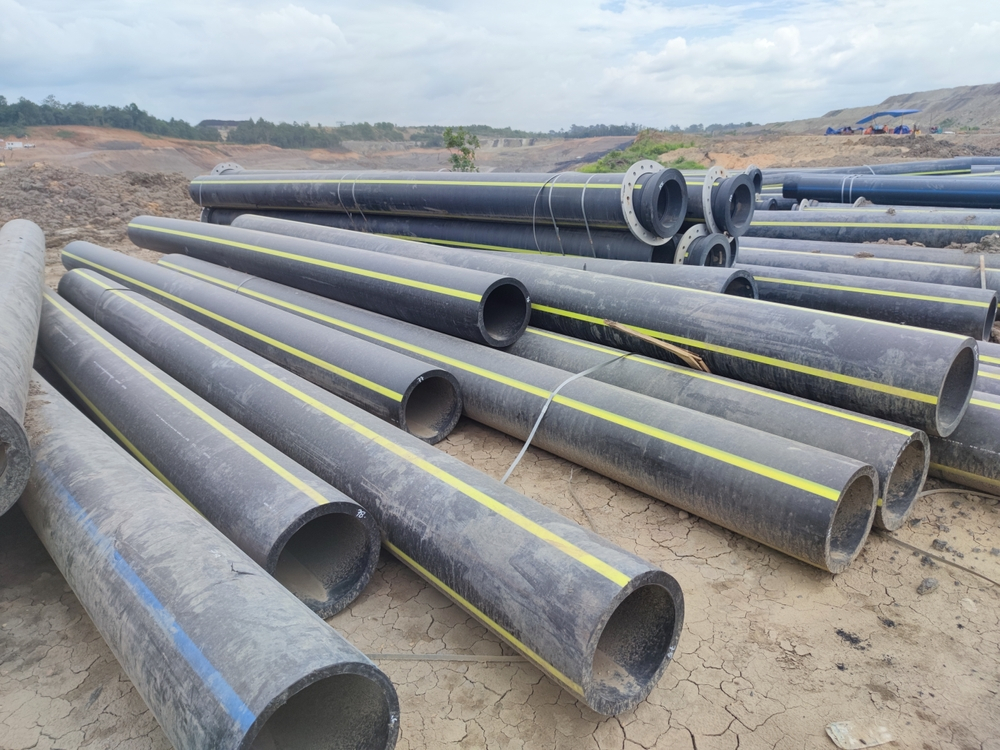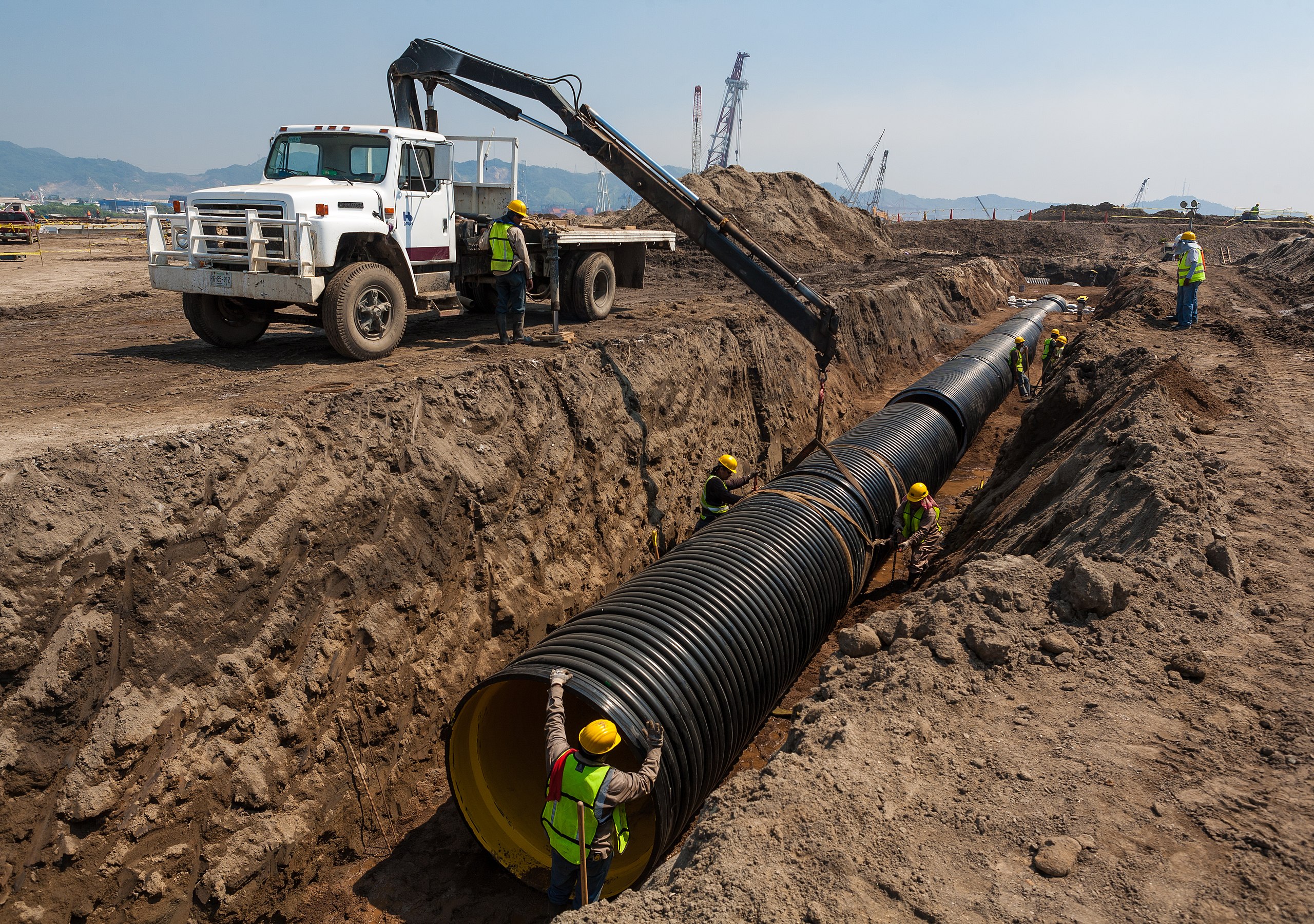Discover the Manufacturing Process Behind High-Quality HDPE Pipeline and Its Applications
The production procedure of premium HDPE pipes is complex and systematic. It starts with the choice of raw products that enhance efficiency. Following this, ethylene undertakes polymerization to develop resin, which is then shaped with extrusion. Quality control is paramount, making certain that the last item fulfills rigorous requirements. The journey of HDPE pipelines doesn't end with manufacturing. Their applications across different markets expose a more comprehensive significance worth examining.
Recognizing HDPE: Characteristics and Advantages

High-density polyethylene (HDPE) is a versatile thermoplastic recognized for its toughness and resistance to various environmental factors. This material displays superb tensile strength, making it suitable for demanding applications. Its low-density framework adds to a lightweight product, assisting in ease of dealing with and setup. HDPE also showcases exceptional resistance to chemicals, which minimizes degradation when exposed to rough substances.
The material's reduced wetness absorption better enhances its durability, making it excellent for usage in pipelines and storage space containers. Additionally, HDPE is resistant to ultraviolet (UV) radiation, making certain that products maintain their integrity even when subjected to sunshine. Its versatility allows for the production of intricate shapes without compromising strength. The environmentally friendly nature of HDPE, often stemmed from recycled materials, contributes to its charm, advertising sustainable practices in production. On the whole, these properties and benefits make HDPE a favored choice for various commercial and customer applications.
Raw Product Choice for HDPE Production
The selection of raw products for HDPE production is vital to validate the last product meets the desired specs and quality criteria. High-density polyethylene (HDPE) is mainly created from polymerized ethylene, acquired from fossil fuels such as gas or unrefined oil. The high quality of these feedstocks significantly affects the mechanical and thermal residential properties of the final HDPE.
Additives additionally play a substantial duty in boosting HDPE's efficiency, including antioxidants, UV stabilizers, and colorants, which improve resilience and resistance to ecological aspects. The option procedure should take into consideration not just the chemical composition of the raw materials but likewise their handling characteristics to ensure reliable production.
The sourcing of raw materials should focus on sustainability and conformity with ecological policies, as responsible methods are vital in today's market. Inevitably, careful resources selection lays the foundation for producing top quality HDPE pipes appropriate for varied applications.
The Extrusion Process: Shaping HDPE Pipeline
The extrusion process plays an essential function in shaping HDPE pipelines, starting with meticulous material prep work methods that guarantee suitable flow and consistency. Equally important is the design of the die, which straight affects the last dimensions and surface area high quality of the pipeline. Together, these variables add considerably to the performance and high quality of HDPE pipe production.
Product Prep Work Strategies
Reliable production of HDPE pipelines starts with precise product preparation strategies, particularly the extrusion procedure. During this stage, high-density polyethylene resin is very first dried to get rid of wetness, making certain excellent circulation qualities. The material is after that fed into the extruder, where it goes through home heating and melting, changing into a thick state. This heating procedure is meticulously controlled to maintain the material's honesty and performance. The liquified HDPE is forced with a die, forming it into a constant pipeline form. Proper temperature management during extrusion is important, as it directly influences the product's buildings and the end product top quality. When formed, the HDPE pipe is cooled down and reduced to defined sizes, all set for succeeding handling and applications.
Die Layout Importance
Precision in die layout plays a crucial role in the extrusion procedure of HDPE pipes. The die works as the last shaping tool, straight influencing the pipe's dimensions, wall density, and surface finish. A well-designed die guarantees uniform product circulation, reducing issues such as abnormalities and weak spots. The geometry of the die must be optimized to fit the particular buildings of HDPE, including its viscosity and thermal habits throughout extrusion. In addition, the cooling rate of the product as it goes through the die can significantly influence the pipeline's architectural honesty. Spending in sophisticated die modern technology is essential for suppliers intending to produce top notch HDPE pipelines that fulfill market requirements and customer expectations.
Top Quality Control Procedures in HDPE Production
Although different aspects affect the top quality of HDPE pipeline production, effective quality assurance measures are crucial to assure uniformity and dependability in the final item. Trick quality assurance techniques include rigorous product assessment, verifying that the raw polyethylene satisfies established criteria for pureness and density. During the extrusion procedure, parameters such as temperature level, pressure, and cooling time are carefully monitored to maintain dimensional precision and architectural honesty
In addition, post-production screening is crucial; makers usually perform hydrostatic tests to analyze the pipe's strength and resistance to stress. Visual examinations for surface area flaws even more improve quality control. Qualification from pertinent standards companies, like ASTM or ISO, provides an additional layer of integrity. By implementing these extensive quality control actions, producers can decrease defects, improve performance, and ensure that the HDPE pipelines fulfill the details demands of various applications, ultimately causing consumer complete satisfaction and trust fund in the item.
Applications of HDPE Pipeline Across Industries
HDPE pipes are used throughout various industries due to their durability and adaptability. In water distribution systems, they ensure reliable shipment, while in wastewater management, they offer trusted services for waste transportation. In addition, agricultural watering networks take advantage of HDPE's resistance to rust and flexibility, making it a perfect option for modern farming practices.

Water Distribution Solutions
A significant variety of markets rely on high-density polyethylene (HDPE) pipelines for reliable water circulation systems. Recognized for their toughness and resistance to rust, HDPE pipelines are widely utilized in local water system networks, agricultural watering, and industrial applications. Their light-weight nature helps with easy handling and installation, minimizing labor costs and time. Additionally, HDPE pipelines can fit different stress levels, making them suitable for both low and high-pressure systems. custom hdpe pipe manufacturing Midland TX. The adaptability of the material enables smooth combination into existing framework, lessening the need for considerable excavation. HDPE's resistance to chemical seeping guarantees that the water provided stays secure and clean, making it an ideal selection for preserving the quality of safe and clean water across various industries.
Wastewater Monitoring Solutions
Efficient water circulation systems also lead the way for cutting-edge wastewater monitoring remedies, where high-density polyethylene (HDPE) pipelines play a significant function. Popular for their sturdiness and resistance to deterioration, HDPE pipelines are excellent for moving wastewater in numerous setups. Their adaptability enables easy installment in complicated environments, minimizing the requirement for comprehensive excavation. Furthermore, HDPE's smooth indoor surface area decreases friction, boosting flow prices and efficiency. These pipelines are likewise resistant to chemical leaching, making sure that pollutants do not jeopardize the surrounding setting. Industries, towns, and treatment facilities increasingly count on HDPE pipelines for their integrity and long life, making them a favored choice for modern wastewater administration systems. This flexibility emphasizes the crucial relevance of HDPE pipes throughout various applications.
Agricultural Watering Networks
Agricultural irrigation networks profit greatly from making use of high-density polyethylene (HDPE) pipes, which provide reliable and reliable water distribution to plants. HDPE pipes are lightweight, making them simple to deliver and set up, while their versatility enables various setups in varied surfaces. These pipelines demonstrate exceptional resistance to deterioration, chemicals, and UV radiation, guaranteeing toughness in harsh agricultural atmospheres. Additionally, their smooth interior surface decreases rubbing loss, maximizing water flow and decreasing power prices related to pumping. The longevity of HDPE pipes, commonly going beyond half a century, adds to lower upkeep and replacement expenses. Farmers progressively depend on HDPE pipes to enhance irrigation efficiency and advertise lasting farming practices, eventually leading to enhanced crop returns and source conservation.

Future Trends in HDPE Pipe Innovation
As the need for sustainable and effective infrastructure expands, advancements in HDPE pipe modern technology are positioned to transform various industries. Emerging trends consist of the combination of wise modern technologies, such as sensing units and IoT capabilities, which promote real-time monitoring of pipe problems, reducing upkeep expenses and avoiding leakages. Additionally, the development of advanced manufacturing strategies, such as 3D printing, is enabling the production of complicated, personalized pipeline styles that accommodate particular task requirements.
Furthermore, the focus on recycling and round economy methods is driving the advancement of HDPE pipelines made from recycled materials, enhancing sustainability. Enhanced jointing techniques, such as electro-fusion and mechanical fittings, are additionally improving setup effectiveness and dependability. Finally, the growing focus on ecological policies is pressing producers to adopt greener manufacturing procedures, ensuring that HDPE pipelines not only fulfill market standards but likewise cultivate an even more sustainable future for facilities development.
Regularly Asked Inquiries
How Does HDPE Compare to Various Other Plastic Materials?
HDPE outperforms several various other plastic products pertaining to toughness, chemical resistance, and flexibility. Its reduced thickness and high tensile strength make it optimal for different applications, usually surpassing options in both efficiency and longevity.
What Are the Ecological Effects of HDPE Manufacturing?
The environmental effects of HDPE manufacturing consist of greenhouse gas discharges, power intake, and possible pollution from producing procedures. Furthermore, improper disposal can bring about soil and water contamination, increasing worries regarding lasting environmental results.
Can HDPE Pipeline Be Reused?
Yes, HDPE pipelines can be recycled. Numerous centers accept made use of HDPE for processing, changing it right into new products. This reusing adds to sustainability efforts, lowering plastic waste while conserving sources and energy in the manufacturing cycle.
What Is the Life Expectancy of HDPE Piping?

Just How Do Temperature Level Variations Influence HDPE Pipe Performance?
Temperature variants significantly influence HDPE pipe performance, influencing flexibility and strength. High temperature levels can result in softening, while reduced temperature levels might create brittleness, eventually website affecting the pipeline's longevity and suitability for different applications in diverse atmospheres.